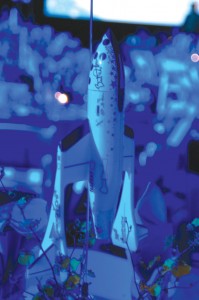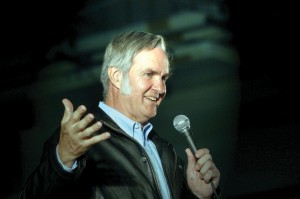By Deb Smith

Burt Rutan smiles as he accepts the Wings Over the Rockies “Spreading Wings” award from Gregg Moss, 9NEWS business reporter and gala master of ceremonies.
Burt Rutan, the nation’s reigning “rocket man” and winner of the $10 million Ansari X Prize, was duly honored in November with the Wings Over the Rockies Air and Space Museum’s “Spreading Wings” award.
Known for his trademark sideburns and cavalier attitude toward government bureaucracy—-the National Aeronautic and Space Administration in particular-—Rutan seized the black-tie opportunity to shift conventional thought on the privatization of manned space flight. Rutan, who made international headlines last year when SpaceShipOne became the first privately funded aerospace vehicle to reach space, said that in order for privatized space flight to have a “coming out,” the marketplace must first return to a more entrepreneurial spirit.
“I think the important thing here is to have the same kind of environment we had back in 1909,” explained Rutan. “The most important thing is for everybody all over the world–not just my folks in Mojave–to have concluded, ‘I can do this.'”
With that in mind, the founder of Mojave, Calif.-based Scaled Composites suggests investment will then flow, designers will start to take risks, and the necessary breakthroughs in technology will happen.
“Sure, there are a lot of crazy ideas out there, and most of them don’t fly, but you have to try things that are nonsensical,” he said.
Rutan added that a reason for a significant portion of the space industry’s current stagnation is that designers and engineers eliminate themselves from competition before they even begin, simply because they restrict themselves to “what they know works.”
“If we have a ‘sensical’ approach determined by people that are smart enough to know not to try something that may not work, we’d never have a breakthrough,” he said.
And it’s these breakthrough moments that Rutan insists are an essential element for manned space flight to be safe enough and cheap enough to attract the general public.
But there’s more. A privatized manned space program also has to be self-supporting. In order to stay competitive and to fuel future breakthroughs, it also has to generate a rapid return on investment, even while in the developmental stage.
“If you’re NASA and you find out something is wrong (with your project), you just get some more money and you spend some more years and you make some more profit while you fix the mistakes,” laughed Rutan. “Paul Allen only gave me so much money and he was taking an enormous risk…and I was under enormous pressure. If I overran the schedule (or budget) then I didn’t have a program at all.”
At the time investor and philanthropist Paul Allen financed the SpaceShipOne project, the X Prize was yet to be funded. But when it did receive a multimillion dollar cash infusion from the Ansari family, Rutan and his team at Scaled Composites had already successfully put a man-—Mike Melvill-—into space.
Rutan saw the promise and the potential in capturing the competition’s $10 million bounty. By simply making two more successful flights in SpaceShipOne, he knew he could not only win the X Prize competition, but also recover approximately 40 percent of Paul Allen’s investment in the program.
And by placing the Virgin Atlantic logo on the spaceship’s tail while the media filmed the X Prize flight, Rutan could rake in another 10 percent for his benefactor.
“That’s kind of cool,” he grinned. “You don’t see the space shuttle painted up like a NASCAR, do you?”
The characterization of the new space race
According to Rutan, the race for space between Russia and the United States has been a long and arduous battle. However, it has also brought about some interesting and ironic changes.
“Back in the ’60s, we had these communists and we didn’t really know what they were doing,” recalled Rutan. “Yeah, they were going to the moon, and yeah, we had to beat them, but in those days, could you have ever imagined that in the future the one place you’d go to buy a ticket as a citizen to fly in space—-which is a very capitalistic thing to do-—would be Russia?”
In April 2001, Dennis Tito became the first suborbital traveler to pay for a trip to space with money out of his own pocket. Two others have followed, and there’s even discussion of a privately funded trip to the moon.
“Could you have ever imagined the Russians going to the moon with hardware they developed in the ’60s and there not be a Russian in the ship?” asked Rutan. “Could you have ever imagined it would be somebody who paid? It sounds silly, but the Russians are beating us as capitalists.”
But not for long, says Rutan.
“What we can do now to beat them is simply do what Americans do best,” he said. “We build a business.”

Each table at the Wings Over the Rockies gala honoring Burt Rutan was appropriately adorned with an autographed model of SpaceShipOne.
The business, said Rutan, must be a space travel business based on high-volume, public access, with an even higher level of safety, to attract investors and render profit. However, Rutan admits that at this point the prospect of private suborbital space travel is still too dangerous. It can only be remedied by innovation-—and consequently, innovation can only be stimulated by taking risks. Calculated risks.
“When you get into a government spaceship, statistically your changes of dying are one in 62,” explained Rutan. “When the door closes, that’s pretty much what you have, but the first commercial airliners had a safety record of about 100 times that.”
He went on to point out that with only maturity “by flying a lot of hours” and no real movement in technology, commercial flight has now become more than 600 times safer than government-sponsored manned space flight.
Rutan said it is quite logical for a nongovernmental space travel company to offer a service to the public with a safety factor equivalent to at least that of the early airliners. He added that at this juncture in time, there’s no way to offer such a service that is as safe as present-day air travel “simply because they have 65 years of maturity.”
The next step
So, private space flight needs an entrepreneurial environment in which to flourish, it needs to be self-supporting and it needs a way to achieve an acceptable return on investment, even in the developmental stages. Rutan insists it also needs to be attractive to the potential passenger.
“The ship we’re developing in our shop right now in Mojave will have a large cabin where I can stand up and float up to the ceiling and put my hands out, and tumble and play with my cap–do what ever I want,” said Rutan. “The windows will have handles on them because if you want to look outside you’re going to have to go and pull your nose up against the window and look…you’re not going to be strapped in a small thing with a little window, because that kind of space flight will not sell the tickets.”
The flights that will sell tickets will be the flights that let travelers experience weightlessness.
While Rutan points out most suborbital flights have less than seven minutes of weightlessness, the experience is still attractive enough to support a workable business model.
Rutan partnered with Virgin Group founder Sir Richard Branson to form The Spaceship Company. They plan to make spaceflight affordable for the masses and to demonstrate the commercial viability of manned space exploration.
The new company owns the designs of the new SpaceShipTwo (SS2) and White Knight Two (WK2) launch systems that are currently in development at Rutan’s Scaled Composites. The Spaceship Company will manufacture the new launch aircraft, spaceships and support equipment and market them to a new breed of space line operators, including the launch customer, Virgin Galactic.
“Initially, it will be very expensive—-because it can be,” he said. “But for SpaceShipTwo to survive in competition that’s coming, we have to develop our first generation of commercial spaceship operating at costs low enough to reach billions of people—-not just billionaires.”
Rutan punctuated that remark with a prediction.
“I believe the ship we’re working on right now, starting with it operating first to fly billionaires, will have flown nearly 100,000 people in 12 years,” he said. “It’s extremely important for there to be big volume achieved.”
All fun and games?
Many may wonder if Rutan’s prospects for the privatization of space travel are nothing more than “joy rides for billionaires—-and when the price comes down, joy rides for millionaires.” The answer is no. It’s all about inspiring the next generation.
“How many people bought an Apple computer when they first came out?” he asked. “So why did you buy it? Probably so you could say, ‘I have a computer at my house and you don’t.'”
So why did computers become more competitive? Games.
“It’s really been a while since any of us have seen any real computer applications,” he said. “We had an entire decade where pretty much personal computers were just for fun.”
Rutan observed this “decade of decadence” was actually responsible for putting the personal computer in everyone’s home. Innovations like the Internet and Google have also contributed to making personal computers a part of everyday life.
“It will soon become hard to convince kids that we didn’t always have computers,” he said. “Much like it is to convince them we didn’t always have electricity in our homes.”
But what Rutan really wanted to drive home was the premise that it’s acceptable to produce and innovate for fun.
“We have done things for fun before that have then enabled breakthroughs,” he said. “And because of this, people who fly in space will be far more creative and will be able to discover and develop far more than any government astronaut could have ever dreamed of, simply because you know you won’t lose your job if you don’t follow the checklist.”
Rutan, whose consistent and consecutive accomplishments have landed him on Time magazine’s list of “100 Most Influential People,” was honored before more than 800 members of the aviation community for his legendary achievement in aviation.
The black-tie gala event held at the Wings Over the Rockies Air and Space Museum was a fundraiser. Proceeds from the event will support the museum’s mission to “educate and inspire” future generations through aerospace.
“We need something to inspire our kids because there hasn’t been an interesting level of improvement in activity for a long time,” he concluded. “I think this could happen by having the capability for them to know that 15 years from now they will know that if they really want to, they can really go into orbit in their lifetime.”

Burt Rutan said that in order for privatized space flight to have a “coming out,” the marketplace must first return to a more entrepreneurial spirit.











